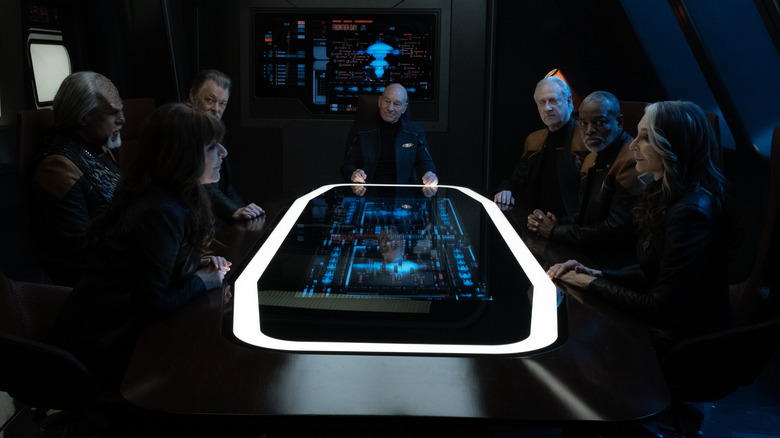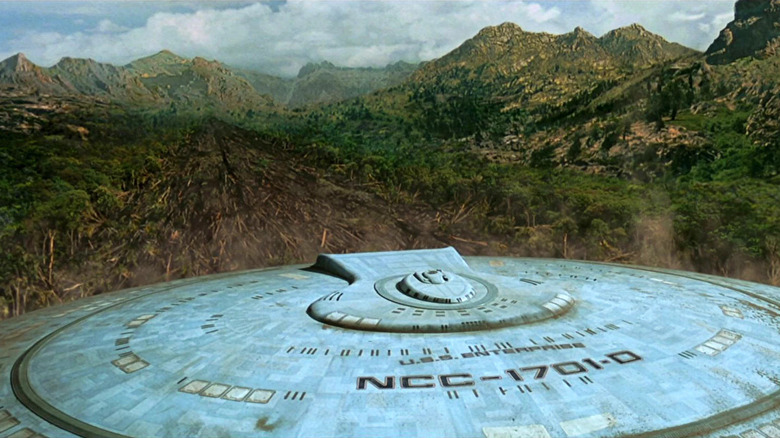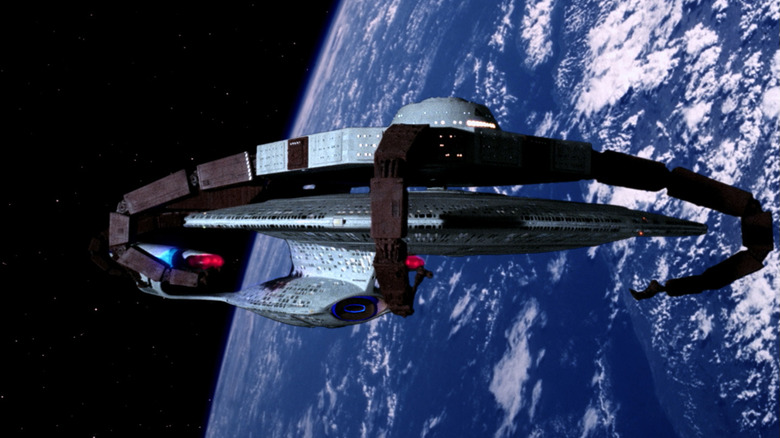Star Trek: Picard Season 3 Just Pushed The Ultimate Nostalgia Button
Warning: this post will contain spoilers about the third season of "Star Trek: Picard."
When the third season of "Star Trek: Picard" was first announced, it sold itself as a nostalgia party. Previously, of the "Star Trek: The Next Generation" cast, only Patrick Stewart, Jonathan Frakes, Marina Sirtis, and Brent Spiner had appeared, and the four never had a scene together. The third season was constructed specifically to gather those four, add Michael Dorn, Gates McFadden, and LeVar Burton to the mix, and get them all in the same room. Refreshingly, the showrunners of "Picard" held said event for the end of the season's eighth episode, allowing each character to be introduced organically. By the time everyone was gathered, the moment of nostalgic reunion felt earned ... if not corny. Additionally, other legacy characters like Ro Laren (Michelle Forbes), Tuvok (Tim Russ), and Commander Shelby (Elizabeth Dennehy) would appear from time to time.
It seems that the wistful around-the-conference-table reunion was the moment the showrunners had been waiting for, and instantly slammed their fists down on the nostalgia button repeatedly. Episode nine, called "Võx," opened the floodgates, and corny NextGen references began to pour through without control. For one, it was revealed that Jack Crusher (Ed Speleers) was infected with a mysterious Borg brain virus and that the Borg had been the real Big Bad this whole time. That's a bit tiresome, I suppose — the Borg again?? — but it's certainly something even non-Trekkies know about.
Moreso, though, the showrunners threw open a pair of garage doors, flicked on the floodlights, and illuminated the glory of a very familiar — and presumably destroyed — Galaxy-class starship. Yes, dear readers, it seems the Enterprise-D has been brought back from the dead.
When we last saw the Enterprise-D ...
While seeing the Enterprise-D again may inflict certain viewers with unavoidable wistfulness, just as many will be rolling their eyes at the cheap shot. It certainly took a great deal of temerity to rebuild a ship that had been destroyed entirely. It made no logical sense that it would be rebuilt. The Enterprise-D, it seems, was salvaged merely so that it could star in a TV show meant to appeal to aging Trekkies who watched "Next Generation" as youths.
The last time we saw the Enterprise-D was in David Carson's 1994 film "Star Trek: Generations." During the course of the film, the Enterprise was led to an uninhabited planet called Veridian III. On their tail was a rival Klingon ship that had, thanks to spy subterfuge, managed to obtain the Enterprise's shield frequency. The Klingon weapons were able to penetrate the Enterprise's shields, effectively trashing the ship. The Enterprise separated its saucer section to flee an exploding warp core, but it wasn't quite fast enough. The explosion forced the saucer section to crash on Veridian III. Picard would later say that the ship couldn't be salvaged.
So how, then, could it be around several decades later to appear in "Star Trek: Picard"? It seems that Geordi La Forge (Burton) works at a starship museum, where many notable ships of Starfleet's past are on display in space. The ship's saucer section, he explains, was rescued largely intact and heavily damaged from Veridian III, and the rest was taken from another Galaxy-class starship. In his spare time, he's been restoring it, and it appears to be spaceworthy. Restoring a 1000-person vessel, one might think, is like singlehandedly restoring a Las Vegas hotel.
Why it's needed
"Star Trek: Picard" has bent over backward — to the point of its head touching the floor — to justify the return of the Enterprise-D and the "Next Generation" crew in the same place at the same time. It seems that the genetic Borg virus only affects those who are under 25, so the cast is protected by dint of their age. Because the Federation just announced a massive, interconnected computer system that remotely links entire fleets of starships, the Borg were able to immediately take advantage. Led by all the under-25s, and united as a destructive force, the Borg were left poised to attack. It's not explained why the Borg wants to attack the Federation beyond their general sense of evil. It is also not explained why they couldn't merely attack in a similar fashion using their own ships.
But attack they will. And, with all the newer starships linked into the shared network, Picard and co. needed to run to the rescue in a ship that was too old to be detected. Hence, their use of the Enterprise-D. A parallel: if someone is using high-tech, signal triangulation scanners to locate your cell phone, you could hoodwink your pursuers by merely using an old-fashioned landline rotary dial phone.
The appearance of the Enterprise is perhaps one of the cornier things to ever happen on "Star Trek," and its brazen exploitation of nostalgia imagery nearly ruins the season (which had, until this episode, been surprisingly judicious with its callbacks and references). This kind of ploy is better left to "Star Wars," which likes to link to its past as often as possible; Rey being Palpatine's granddaughter, for instance.
But, if nostalgia is all you crave, "Võx" presents it by the shovelful.


